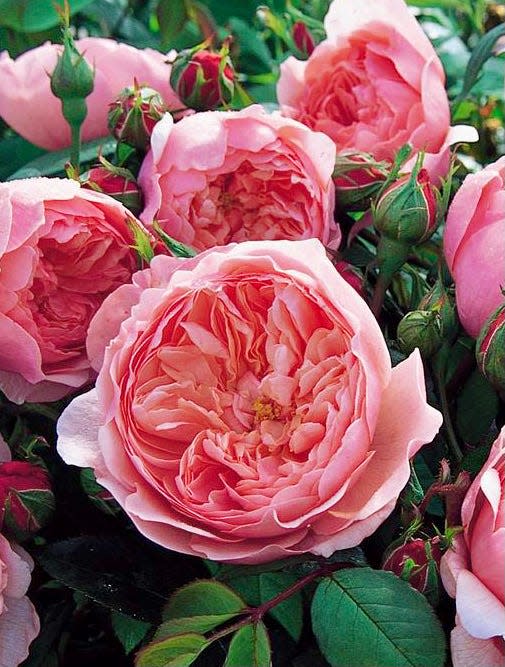Master Gardener: English Roses are perfect for American gardens
- Oops!Something went wrong.Please try again later.

I’ve always fancied myself a bit of an Anglophile (yes, I did just see the second Downton Abbey movie yesterday) so my love of David Austin’s English roses comes naturally to me. I bought my first five English roses when I lived in Columbus in the 1990s and have delighted in growing several different varieties since that time.
For anyone unfamiliar with them, “English Roses” is the name the now deceased hybridizer David Austin gave to a new race of roses originating in the hybridization of old roses from the 18th and 19th centuries (Gallicas, Damasks, Portland, and Bourbon roses) with present day roses (hybrid teas, floribundas). His first commercial rose was Constance Spry in 1961 and since then he has released more than 200 roses, now beloved throughout the world.
Since the goal was to develop an old-fashioned look, those who are looking for the high-centered form of modern hybrid teas may be disappointed. Also, there are many who may prefer the ease-of-care roses such as the Bill Radler Knock-Out Roses, the Easy Elegance or flower carpet roses.
English roses, however, have their own special qualities that make them not only indispensable but for me, even preferable to other roses.
English roses have a fine scent
Firstly — the fragrance. Do you ever tire of hearing, “Roses today don’t smell as nice as they used to”? Well, English roses do. Their scents are classified into four principal categories — “Myrrh,” “Old Rose,” “Tea Rose”, and “Fruit.” The Old Rose scent is particularly luxurious and probably the most beautiful. Heavenly. (And when was the last time you bent over to smell a Knock-out-rose?)

Secondly — how many roses will reward you with sumptuous blooms with less than six hours of direct sun? Well, many English roses can do just that with as little as four to five hours direct sun. In a particularly warm summer, they actually prefer to be shaded from the midday sun. Pale and pastel-colored ones actually do better with shade as their flowers and fragrance last longer than those grown in full sun.
Thirdly — while English roses may not be as easily managed as the afore-mentioned Knock Outs, they still are mostly low maintenance, particularly in comparison to the finicky hybrid teas.
They have more disease resistance and are much hardier in our Zone 6 winters. I don’t believe I’ve ever lost an English rose and that includes a particularly brutal one in the 1990s that one day reached a low of minus-22 degrees.
For sheer flower power and versatility, it’s hard to beat these roses. Even young bushes are loaded with buds in May and June and appear to repeat bloom faster than your average hybrid tea. Several of them can be used as climbers from 10 to 12 feet. English roses do respond well to pruning, however, and can be easily managed to shrub proportions. Color selection is many and varied with shades of apricot, pink, peach, salmon, white, red, copper and buff. Among the strongest growers (and my personal favorites) are those of the yellow class.
Favorite rose is Graham Thomas
My favorite English rose is Graham Thomas. It is an easy to grow rich, pure yellow with a strong, fresh tea scent. This was the first rose popularized in the United States and was voted Worlds Favorite Rose by 41 national rose societies in 2009.
Among many other fine roses are Crown Princess Margareta — a lovely apricot that thrives under tough conditions and has a strong, fruity tea rose fragrance. The Ancient Mariner is a beautifully formed, large flowered luminous pink. The Lady of Shallot and Abraham Darby are very good roses for the beginning enthusiast.
Many English roses have names related to English people, places, even literary characters. My favorites are his Thomas Hardy’s Jude the Obscure, Tess of The Durberilles, Wildeve, Eustacoa Vye.
There is also an Emily Bronte, a Heathcliff, even a Brother Cadfael. (I’ve yet to get an Anne Boleyn — couldn’t bear to disband her, too much like beheading).
One problem you might have is finding these roses locally. I called several nurseries here that formerly carried them but do so no longer. (I get mine from Oakland Nurseries in Columbus, they have a fine selection and reasonable prices).
Amazon carries them but they are expensive. David Austin will send an extremely informative catalog where you can order his roses from his base in Tyler, Texas. Website is DavidAustinroses.com.
In closing I hope I have created a bit of enthusiasm for those “queens of the garden”. They really are perfect for English and our American gardens.
Charles Gaydos is a Master Gardener with the Sandusky and Ottawa Counties Extension Offices.
This article originally appeared on Fremont News-Messenger: Master Gardener: English Roses are perfect for American gardens

